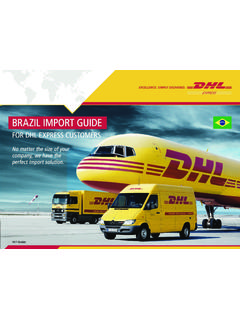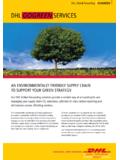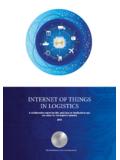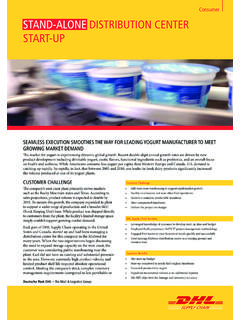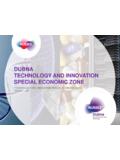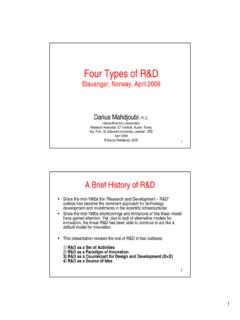Transcription of Internationalization – a driver for business …
1 Internationalization a driver for business performanceJanuary 20132 DHL Internationalization a driver for business performance1. Introduction 3 Background Methodology 52. Analysis International SMEs 8 International business activities 8 International competitive advantages 15 High-performers 17 High-performing SMEs 17 International high-performing SMEs 183. Conclusion 234. Annexes 25 Annex 1: Questionnaire: drivers of competitiveness for SME s trading internationally 26 Annex 2: Country focus 31 Table of conTenTs3 DHL Internationalization a driver for business performance1. InTroducTIon 4 DHL Internationalization a driver for business performanceIn an exacting economic environment, small and medium sized enterprises (SMEs) have been presented with a challenge. A challenge to grow and increase the profitability of their businesses against a backdrop of often weak report summarises the results of research into the performance and competitiveness of SMEs in this business environment, with a specific focus on attempts by SMEs to internationalise their businesses and how this impacts on their growth.
2 The research involves analysis of SMEs across 12 countries the G7 and the BRIC economies with the addition of another emerging market, Mexico ( BRICM ). The report studies SMEs that have international operations, as well as high-performing SMEs (see below for definition). Of particular interest is the overlap between these two groups SMEs that have international operations and are high-performing prompting the thought that trading internationally is itself a driver of performance. The main purpose of the study is to1. Identify and describe international SMEs, their drivers and Draw insights of what makes an international SME Background SMEs a definitionThe definition of small and medium-sized enterprises (SMEs) varies by country, but is usually based on staff numbers and revenue, sometimes on the value of assets. They are a heterogeneous group with a diverse range of company sizes, capabilities and business activities: from the artisan producing agricultural implements for the local market, to a sophisticated engineering or software firm selling in overseas markets.
3 Our study uses the most widely accepted definition, shared by the European Union and by a large number of OECD countries, which is a company with: Between 10 and 249 employees Annual turnover of less than 50 millionAn important point to note is that micro enterprises (MSMEs), which have fewer than 10 employees, are excluded from our analysis to avoid a skew towards businesses that operate on a local-only basis. SMEs contribution to the economySmall and medium-sized enterprises (excluding MSMEs) occupy an important position in any country s economy and typically employ around 35-45% of the work force and contribute 30-40% of national added value. As the backbone of economic activity (bridging the gap between many micro enterprises and the few large ones), they stimulate growth and help diversify economic activity; they are flexible and can adapt quickly to changing market demand and supply situations; they drive innovation; and they make a significant contribution to exports and Internationalization a driver for business performanceSMEs international competitiveness As trade barriers are removed and logistics and communication costs fall, small and medium-sized enterprises have adapted to new challenges to stay competitive in an international marketplace.
4 These developments have also opened up opportunities for SMEs. Their integration into the global economy has prompted them to develop new international activities such as attempting to open new markets; adding more value to their products and services; and reducing their cost an SME s international competitiveness requires consideration of the economic , political and social aspects within the SME s country of origin, as much as looking at the SME itself. Both levels of analysis have to be taken into account in this research: The macro level, national competitive advantages, such as access to new technologies, skilled labour, market structure, logistics and infrastructure. The micro level, company-specific competitive advantages, such as price, quality, service, responsiveness and innovation. MethodologyThe study has drawn upon recent studies of SMEs; from IHS proprietary data and reports; and most significantly from primary research of SMEs through an online Approach Note: The SME sample for the primary research is based on 410 respondents owners or members of the senior management team at SMEs having between 10 and 249 employees.
5 The questionnaire can be found in Annex 1 of this research of existing literature World Bank OCDE Eurostat World economic ForumIHS Data World Industry Service (WIS) World economic Service (WES) World Trade Service (WTS) Online questionnaire survey SMEs (10 to 249 employees and an annual turnover of less than 50 million) 12 countries, 2 groups: G7 and BRICM countries Research completed October 2012 Follow-up interviews with SMEsIdentification and description of international SMEs, their drivers and challengesMacroeconomic analysisMicroeconomic analysisDraw insights of what makes an international SME competitive6 DHL Internationalization a driver for business performancePerformance indicatorsWe identified a group of high-performing SMEs based on their average annual growth rate over last three years. These were defined as SMEs who have achieved: More than 10% average annual growth rate over last three years for G7 countries (on average, the G7 countries had a 1,58% growth in GDP) More than 20% average annual growth rate over the last three years for BRICM countries (on average, the BRICM countries had a 5,84% growth in GDP)The study also classified SMEs by key competitive advantage; were they efficiency or innovation driven.
6 Of course, all SMEs have a mix of both criteria but, through our research, we were able to classify two groups according to their predominant business characteristic. Efficiency-driven companies compete on the basis of efficient production processes, quality product improvements and well-organised logistics services Innovation-driven companies compete by providing new or unique products / services creating their own market7 DHL Internationalization a driver for business performance2. analysIs8 DHL Internationalization a driver for business performanceOur first group of interest is international SMEs that operate in two or more countries; typically 70% of country respondents. International SMEs Source IHS survey International business activities International SMEs have developed multi-faceted international activitiesSmall and medium-sized enterprises are affected by globalisation and are increasingly forced to think and act internationally. The first finding of this study is that SMEs Internationalization no longer has a limited focus on exporting / importing, but has become a much more differentiated business activity encompassing subcontracting as well as technical or commercial cooperation.
7 SMEs may be engaged in cross-border partnerships and foreign investments to capitalize on new opportunities. Smaller SMEs are less internationalised than bigger SMEs, but even for them, Internationalization is today a reality. While 80% of SMEs with 50 to 249 employees are operating at an international level, 66% of SMEs with 10 to 49 employees are international. One point to notice nevertheless, is that the size difference is still marked when analyzing the share of small-sized enterprises with more complex forms of Internationalization , or a combination of more than one form of Internationalization . 020406080100 TotalUnitedStatesUnitedKingdomRussiaMexi coJapanItalyIndiaGermanyFranceChinaCanad aBrazilInternationalNational activity only5%95%39%61%19%81%5%95%6%94%32%68%42% 58%26%74%29%71%23%77%50%50%42%58%27%73%I nternational business activitiesSource IHS survey 2012 THE ModErn SME MAy wEll BE EngAgEd In InTErnATIonAl business ACTIvITIES BEyond IMPorT / ExPorT9 DHL Internationalization a driver for business performanceNB: Technical cooperation defined as, for example, sharing know-how, technologies etc.
8 Commercial cooperation defined as marketing, distribution survey identified a high number of SMEs having international activities within their first five years of existence. For instance, while 27% of all SMEs have more than one international activity, this indicator rises to 31% of SMEs with less than five years of trading, despite them obviously having had less time to expand their businesses (a general assumption would likely be that the figure would be much lower for younger SMEs). This demonstrates a growing trend towards the Internationalization of SMEs. Young international SMEs are a reality of today s economy and are, in our survey, responsible for an important part of SME Internationalization . In fact, recent literature points to a growing number of such firms trading internationally within the first five years of their creation. These born global SMEs see themselves as international rather than national , these born global SMEs are also more prevalent in BRICM countries (24%) than in G7 countries (13%).
9 The rationale behind this could be that BRICM based small and medium-sized enterprises are strategically more focused on international markets than their G7 than 1 activityCommercial cooperation Technical cooperation SubcontractingImportsExportYe sNo70%30%77%23%84%16%75%25%79%21%73%27%P ercentage of SMEs involved in international business activitiesSource IHS survey 2012Q. In which international business activities is your company engaged?A high-performing SME based in the UK The major challenge for SMEs operating internationally is not lack of resources for instance, staff are often more flexible and committed than those at large companies but the lack of experience of the management team in the initial phase, and the lack of confidence by investors that SMEs have a role to play at an international level. 10 DHL Internationalization a driver for business performanceCommunication technologies and transportation infrastructure One of the major forces enabling economic globalisation and Internationalization of companies is the proliferation of inexpensive communication technologies and efficient logistics services that have eroded national borders and distance.
10 Observing the speed and the minimal cost with which information, products or services can be transmitted across geographic space, we can talk about the world as a global village accessible to all companies. The table below shows the speedy take up of new technologies in BRICM countries which is a part of the explanation of the successful Internationalization of BRICM based SMEs. Today, more than ever before, a small and medium-sized enterprise can use not only extensive and efficient communication tools, but also transportation infrastructures to reach out to large targeted audiences, to customize products and services and meet international demand. To some extent, this is the strategy employed by German SMEs, commonly referred to as the Mittelstand. One of the major strategic instruments deployed by this kind of company is the combination of product specialisation and geographic fact, inadequate transport infrastructures and insufficient supply of private distribution and logistics services will constrain competitiveness by limiting efficient product and service delivery.


